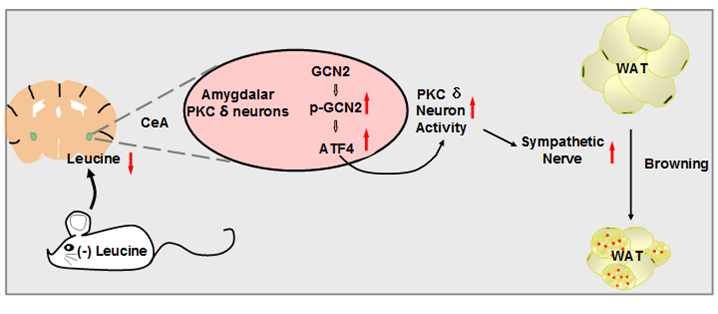Chinese Researchers Reveal New Mechanism of Central Amygdala in Sensing Amino Acid Deprivation to Regulate WAT Browning
There are two types of adipose tissue in humans, consisting of white adipose tissue (WAT) to shore energy and brown adipose tissue (BAT) to thermogenesis. Under certain conditions, WAT can change to BAT-like adipocytes via a process called as WAT browning. In addition to being stimulated by cold exposure, WAT browning may also stimulated by intermittent fasting or a low-protein/high carbohydrate diet, suggesting that nutrients may also be an important external stimulus for this regulation.
Amino acids are critical metabolic signals for many important functions like lipid metabolism, glucose utilization and energy expenditure. However, it remains unknown whether WAT browning is induced on this condition. The hypothalamus is important in regulating browning, however, other brain areas remain largely unknown.
A recent study by Dr. GUO Feifan’s research team from Shanghai Institute of Nutrition and Health (SINH) of the Chinese Academy of Sciences (CAS) reveals that leucine deprivation promotes WAT browning, and this regulation is mediated by GCN2/ATF4 signals in amygdalar PKC-δ neurons.
This study showed that leucine deficient diet could induce WAT browning in mice and increase the activity of amygdalar PKC-δ neurons, using designer receptors exclusively activated by designer drugs (DREADDs) to inhibit PKC-δ neurons largely blocked leucine deprivation induced WAT browning. As GCN2/ATF4 signaling is the crucial pathway of sensing the amino acid deficiency, researchers found the GCN2/ATF4 signals of PKC-δ neurons were increased, and knocking down GCN2 or ATF4 respectively could reverse WAT browning during leucine deficiency. As the downstream of the GCN2, ATF4 activation prevented the influence of GCN2 to WAT browning.
Moreover, as the central nerve system (CNS) could deliver signals to peripheral tissues, researchers then found lack of leucine stimulated the sympathetic nervous system (SNS) and pharmacologic SNS ablation inhibited the browning process. In addition, stimulation of SNS activity by agonist reversed the effect to browning in PKC-δ neuron-inhibited mice.
In summary, this study revealed that leucine deprivation could induce WAT browning. This process was mediated by GCN2/ATF4 signals in amygdalar PKC-δ neurons and further stimulated SNS to promote browning. The research supplies a new perspective for exploring the relation of the brain, nutrition and metabolism, and provides theoretical basis and direction of WAT browning research.
The study entitled “Activation of GCN2/ATF4 signals in amygdalar PKC-δ neurons promotes WAT browning under leucine deprivation” was published online in Nature Communications on June 5, 2020. Dr. GUO Feifan is the corresponding author and Dr. FEI Xiangyuan is the first author. This study was also supported by Dr. CHEN Yan, Dr. ZHAI Qiwei and Dr. YING Hao from SINH. The study was funded by the grants from National Key R&D Program of China, the National Natural Science Foundation of China, Basic Research Project of Shanghai Science and Technology Commission and CAS Interdisciplinary Innovation Team.

Leucine deprivation promotes WAT browning, which is mediated by GCN2/ATF4 in amygdalar PKC-δ neurons and sympathetic nerve. (Image provided by Dr. GUO Feifan's Group)
Media Contact:
WANG Jin (Ms.)
Shanghai Institute of Nutrition and Health,
Chinese Academy of Sciences
Email: sibssc@sibs.ac.cn
